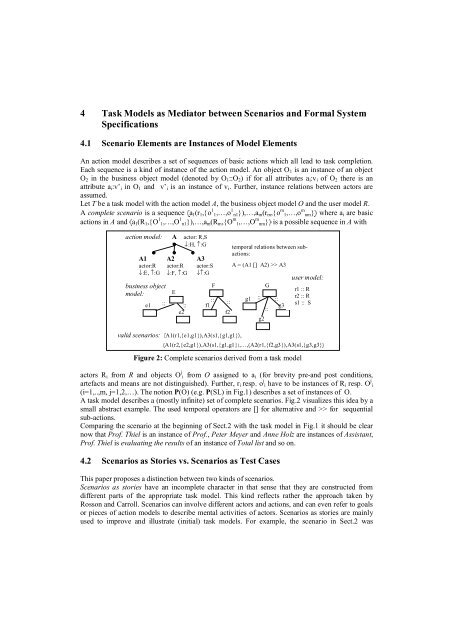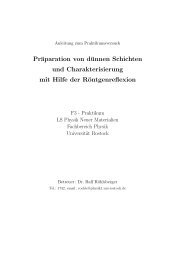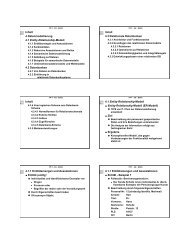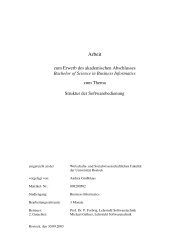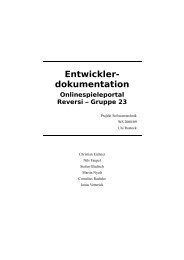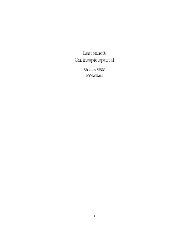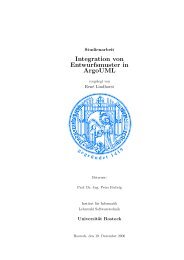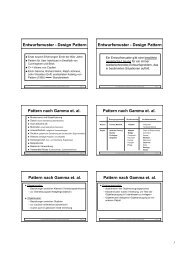paper - Universität Rostock
paper - Universität Rostock
paper - Universität Rostock
Create successful ePaper yourself
Turn your PDF publications into a flip-book with our unique Google optimized e-Paper software.
4 Task Models as Mediator between Scenarios and Formal System<br />
Specifications<br />
4.1 Scenario Elements are Instances of Model Elements<br />
An action model describes a set of sequences of basic actions which all lead to task completion.<br />
Each sequence is a kind of instance of the action model. An object O 1 is an instance of an object<br />
O 2 in the business object model (denoted by O 1 ::O 2 ) if for all attributes a i :v i of O 2 there is an<br />
attribute a i :v’ i in O 1 and v’ i is an instance of v i . Further, instance relations between actors are<br />
assumed.<br />
Let T be a task model with the action model A, the business object model O and the user model R.<br />
A complete scenario is a sequence a 1 (r 1 ,{o 1 1,…,o 1 n1}),…,a m (r m ,{o m 1,…,o m nm}¡ where a i are basic<br />
actions in A and a 1 (R 1 ,{O 1 1,…,O 1 n1}),…,a m (R m ,{O m 1,…,O m nm}¡ is a possible sequence in A with<br />
action model: A actor: R,S<br />
↓:H, ↑:G<br />
A1<br />
actor:R<br />
↓:E, ↑:G<br />
business object<br />
model:<br />
e1<br />
::<br />
A2<br />
actor:R<br />
↓:F, ↑:G<br />
E<br />
::<br />
e2<br />
A3<br />
actor:S<br />
↓↑:G<br />
F<br />
::<br />
f1<br />
::<br />
f2<br />
temporal relations between subactions:<br />
A = (A1 [] A2) >> A3<br />
g1<br />
::<br />
g2<br />
G<br />
::<br />
::<br />
g3<br />
user model:<br />
r1 :: R<br />
r2 :: R<br />
s1 :: S<br />
valid scenarios: ¢ A1(r1,{e1,g1}),A3(s1,{g1,g1}£ ,<br />
Figure 2: Complete scenarios derived from a task model<br />
¢ A1(r2,{e2,g1}),A3(s1,{g1,g1}£ ,…,¢ A2(r1,{f2,g3}),A3(s1,{g3,g3}£<br />
actors R i from R and objects O j i from O assigned to a i (for brevity pre-and post conditions,<br />
artefacts and means are not distinguished). Further, r i resp. o j i have to be instances of R i resp. O j i<br />
(i=1,..,m, j=1,2,…). The notion P(O) (e.g. P(SL) in Fig.1) describes a set of instances of O.<br />
A task model describes a (mostly infinite) set of complete scenarios. Fig.2 visualizes this idea by a<br />
small abstract example. The used temporal operators are [] for alternative and >> for sequential<br />
sub-actions.<br />
Comparing the scenario at the beginning of Sect.2 with the task model in Fig.1 it should be clear<br />
now that Prof. Thiel is an instance of Prof., Peter Meyer and Anne Holz are instances of Assistant,<br />
Prof. Thiel is evaluating the results of an instance of Total list and so on.<br />
4.2 Scenarios as Stories vs. Scenarios as Test Cases<br />
This <strong>paper</strong> proposes a distinction between two kinds of scenarios.<br />
Scenarios as stories have an incomplete character in that sense that they are constructed from<br />
different parts of the appropriate task model. This kind reflects rather the approach taken by<br />
Rosson and Carroll. Scenarios can involve different actors and actions, and can even refer to goals<br />
or pieces of action models to describe mental activities of actors. Scenarios as stories are mainly<br />
used to improve and illustrate (initial) task models. For example, the scenario in Sect.2 was


